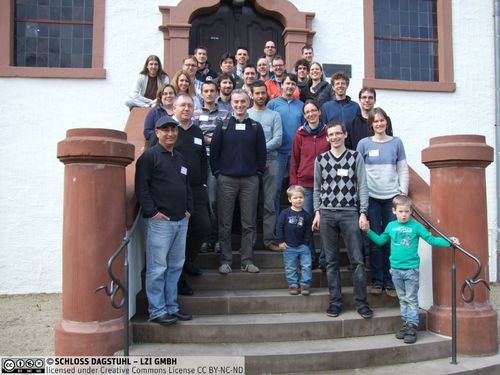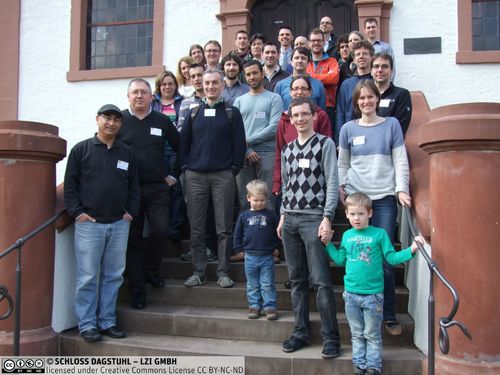Dagstuhl Seminar 14132
Interaction and Collective Movement Processing
( Mar 23 – Mar 28, 2014 )
Permalink
Organizers
- Maike Buchin (Ruhr-Universität Bochum, DE)
- Luca Giuggioli (University of Bristol, GB)
- Guy Theraulaz (Université Paul Sabatier - Toulouse, FR)
- Marc van Kreveld (Utrecht University, NL)
Contact
- Christina Schwarz (for administrative matters)
Movement processing is an emerging research area for analyzing increasing amounts of movement data. This data is typically given as time-stamped sequences of locations, called trajectories, which represent the movement of an entity or an agent in space. Often trajectories are created by sampling GPS locations and attaching a time-stamp, but they can also originate from RFID tags, video, or radar analysis. Huge data sets exist for entities as diverse as ants, fish, birds, deer, traveling humans, sport players, vehicles, and hurricanes.
During recent years automated analysis tools for movement data have been developed, including methods for clustering, performing similarity analysis, segmenting a trajectory, and characterizing patterns such as flocking. Since these computations are mostly spatial, algorithmic solutions have been developed in the areas of computational geometry and GIScience.
Simultaneously, in the area of ecology the study of animal motion has also received increasing interest, in particular, the study of collective motion whereby a group of individuals move in coordination, with or without a specific leader. Although the motivation for the observed movement patterns are various, e.g., foraging, escape from predators, or change of climatic conditions, the mode of movement is mainly determined by social interactions, energy efficiency, distribution of resources, and the natural environment.
This Dagstuhl seminar will address three main topics which go beyond traditional movement analysis and help to provide a way forward at the interface of automated methodologies of trajectory analysis and certain topics in ecology, in particular collective motion, and motion interaction.
Moving entity data processing.
Many questions in interaction and collective motion can only be solved if the movement of an agent is captured and pre-processed suitably. We plan to address situations where a simple GPS reading to get a location at a certain time is insufficient. Relevant research questions include: How to integrate movement paths collected from different sources (e.g. video, RFID, GPS) into one common type, and attach meta-data on quality that is relevant for the analysis? How to model entities and entity motion beyond single-point representations?
Incorporating auxiliary data in movement data analysis.
Merging external factors, e.g. land-cover, weather, environmental heterogeneity, and internal motivation, e.g. heart-rate, emotional state, hunger level, into the analysis of moving agents promises to open up a plethora of novel and exciting possibilities. Relevant research questions include: How to model the heterogeneity of the environment, and how to develop general analysis methods for movement paths in such environments. How to model changes in motion of an entity due to direct or indirect interaction with another entity, and how to compute such changes eff iciently? How to categorize behavioral states and their consequence on individual's motion from the analysis?
Collective motion analysis.
Entities often move in groups that form, split, merge, and end. On a smaller time scale, collective behavior and mutual influence can be seen. Modeling this behavior and coupling it to the different motivations for entities to move is a challenging task. Relevant research questions include: How to define characteristics of collective motionfrom the movement paths of its entities and how to compute these? How to formalize collective motion such that it can be compared across two separate populations of moving entities? How to infer and model an individual's interactions with its close neighbors from its movement path? How to relate collective motion to the environment as referred to in the second topic?
Specific goals.
These topics are relatively unexplored, in particular, when it comes to thoseaspects of mutual interest to ecologists and computer scientists. Collective motion has not been viewed from an algorithmic perspective, and we plan to set the first steps toward establishing real collaboration between researchers from these two fields. We hope and expect that the cross-fertilization will lead to new insights and new directions in either area.
- Better understanding an integration of ecology and computer science research communities (related to movement analysis).
- New insights into the challenges and solution directions relating to the questions listed in this text.
- Setting a research agenda for collective movement analysis.
- Initiating interdisciplinary collaboration.
The Dagstuhl Seminar on Interaction and Collective Movement Processing brought together a group of 30 scientists with varied backgrounds, but with a shared interest in computations involved in the processing of moving entity data, like humans or animals. There are different reasons for such computations: they are needed for the initial processing (cleaning, recognition), for the analysis (derived properties, patterns), and for more advanced features like characterizing and modelling interaction between entities. This seminar focused on the latter, the hardest of these tasks. The majority of the participants had a background in ecology, behavioral sciences, or geometric algorithms, but there were also participants from statistical physics, GIScience, and computer vision.
The seminar featured four invited talks in four main research fields: ecology (Greg Stephens), computational geometry (Jack Snoeyink), GIScience (Patrick Laube), and collective motion (Andrea Perna). The remainder of the program consisted of short presentations, open problem sessions, break-out groups to work on open problems, and reporting sessions based on research done in the break-out groups.
While the original intention was to tackle the challenging problems of interaction and collective motion, part of the research was done on other closely related topics in movement analysis, like quality issues in movement analysis. The problems that were investigated - also described in this report - have led to the start of new research, which was exactly the purpose of the seminar.
The participants enjoyed both the seminar setting and the interdisciplinarity of the seminar, which gave a new impulse to the research of many. A number of collaborations have started up, and we hope that these not only lead to publications but also to longer lasting collaborations. While all participants would be happy to return to such a seminar later, it was agreed that the focus will shift to keep the dynamics and cross-fertilization of different research fields.
 Maike Buchin, Luca Giuggioli, Guy Theraulaz, and Marc van Kreveld
Maike Buchin, Luca Giuggioli, Guy Theraulaz, and Marc van Kreveld
- Ulf Blanke (ETH Zürich, CH) [dblp]
- Kevin Buchin (TU Eindhoven, NL) [dblp]
- Maike Buchin (Ruhr-Universität Bochum, DE) [dblp]
- Edward A. Codling (University of Essex, GB)
- Matt Duckham (The University of Melbourne, AU) [dblp]
- Roland Geraerts (Utrecht University, NL) [dblp]
- Luca Giuggioli (University of Bristol, GB) [dblp]
- Asja Jelic (CNR - Rome, IT) [dblp]
- Andrea Kölzsch (MPI für Ornithologie - Radolfzell, DE) [dblp]
- Patrick Laube (ZHAW - Wädenswil, CH) [dblp]
- Maarten Löffler (Utrecht University, NL) [dblp]
- Ugo Lopez (Université Paul Sabatier - Toulouse, FR)
- Ran Nathan (The Hebrew University of Jerusalem, IL) [dblp]
- Ko Nishino (Drexel Univ. - Philadelphia, US) [dblp]
- Nicholas Ouellette (Yale University, US) [dblp]
- Andrea Perna (Uppsala University, SE) [dblp]
- Ross Purves (Universität Zürich, CH) [dblp]
- Stef Sijben (Ruhr-Universität Bochum, DE) [dblp]
- Jack Snoeyink (University of North Carolina at Chapel Hill, US) [dblp]
- Bettina Speckmann (TU Eindhoven, NL) [dblp]
- Frank Staals (Utrecht University, NL) [dblp]
- Greg J. Stephens (VU University - Amsterdam, NL) [dblp]
- Guy Theraulaz (Université Paul Sabatier - Toulouse, FR) [dblp]
- Gilles Tredan (LAAS - Toulouse, FR) [dblp]
- Stefan van der Spek (TU Delft, NL) [dblp]
- Marc van Kreveld (Utrecht University, NL) [dblp]
- Yusu Wang (Ohio State University - Columbus, US) [dblp]
- Carola Wenk (Tulane University - New Orleans, US) [dblp]
- Yossi Yovel (Tel Aviv University, IL) [dblp]
Related Seminars
- Dagstuhl Seminar 08451: Representation, Analysis and Visualization of Moving Objects (2008-11-02 - 2008-11-07) (Details)
- Dagstuhl Seminar 10491: Representation, Analysis and Visualization of Moving Objects (2010-12-05 - 2010-12-10) (Details)
- Dagstuhl Seminar 12512: Representation, Analysis and Visualization of Moving Objects (2012-12-16 - 2012-12-21) (Details)
- Dagstuhl Seminar 16022: Geometric and Graph-based Approaches to Collective Motion (2016-01-10 - 2016-01-15) (Details)
- Dagstuhl Seminar 17282: From Observations to Prediction of Movement (2017-07-09 - 2017-07-14) (Details)
Classification
- bioinformatics
- data structures / algorithms / complexity
- modelling / simulation
Keywords
- trajectories
- movement
- data analysis
- algorithms
- collective motion
- spatio-temporal data



 Creative Commons BY 3.0 Unported license
Creative Commons BY 3.0 Unported license
